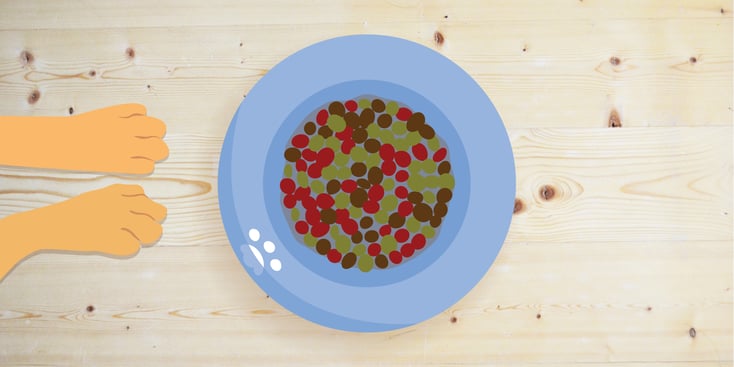Grain Free vs. Grain Dog Food: Which One’s Best?

Grain-Free vs. Grain Dog Food
As veterinarians, this is a question that we get asked on almost a daily basis. Pet parents have been advertised to by food companies promoting the many health benefits of grain-free diets, particularly for dogs with food allergies or intolerances, and want to consider this option for their pet. They may have also heard about dogs going into heart failure as a result of being fed a solely grain-free diet. The truth is, we are still actively learning about the benefits and risks of including grain in dog food in varying quantities. This is an ever-expanding area of research, and one that pet parents need to keep a constant eye on as more research is being carried out. So, what do we know about the ongoing debate about grain vs grain-free dog food?
Benefits of Feeding Grain to Dogs
All dogs need carbohydrates in varying quantities for fuel for the body. Carbohydrates are used to provide energy for daily functions. Any leftover carbohydrates are converted and stored in the body for future energy needs. Grain is an excellent source of carbohydrates, so it is added to dog foods to fulfill the carbohydrate requirement of the diet. It’s cheap, easy to source, and doesn’t spoil easily once packaged making it a good carbohydrate source choice. Another benefit of grains is that they often contain a source of fermentable fiber, which promotes good gut health by feeding the microflora present in the gut. That said, it’s important to pay attention to the list of top ingredients that are beneficial to dogs when managing your pet’s diet, such as healthy fats, fiber, vitamins, and minerals.
Grain Allergies in Dogs
Gluten allergies or intolerances in people are commonplace. Dogs can suffer from food allergies just like people. Food allergies in dogs affect around 1% of the general dog population. While dogs can develop an allergy to grains, it’s very rare. Gluten intolerance has only been found to affect one genetic line in one breed. However, as the human ‘gluten-free’ trend spread, it moved across into pet foods. This has led to the production of grain-free diets to accommodate this perceived need in the pet food market.
Signs that your pet may have a cutaneous food allergy to a food source such as wheat, beef, or dairy are:
-
Red, raw patches on the skin
-
Ear or skin infections
There are no tests, other than an elimination diet trial, that can reliably detect food allergies in dogs, but your vet can help you rule out other causes of your dog’s symptoms to help narrow down the diagnosis. If you are concerned, talk to a veterinarian today.
In addition to food allergies, there are also food intolerances, so while your dog may not be truly allergic to a particular food group, they may have intolerance which can show through signs of weight loss, diarrhea, or loose stool. Avoiding food groups or proteins, or changing food brands can help spot a food intolerance.
One major benefit of grain-free diets is that they are mainly targeted toward dogs with food allergies or intolerances, so have unique protein sources aimed to reduce the chances of food allergies occurring. They also contain supplements like omega oils which are beneficial for skin healing and skin health.
What Are the Disadvantages of Grain-Free Feeding?
Grain-free diets still need a carbohydrate source, so many diets use legumes such as peas or lentils as a replacement. The theory is that these legumes restrict the absorption of taurine (an essential amino acid) from the diet into the bloodstream. Some grain-free diets that don’t use legumes as the main carbohydrate source may have low taurine levels in the diet. Taurine is important in heart function. Low taurine levels over time can affect the heart, leading to a heart condition called dilated cardiomyopathy (DCM) and heart failure.
There is a pet blood test to measure the amount of taurine in your dog’s body, which can indicate whether the diet is the cause of the heart disease or not. Sometimes if low taurine is detected in the blood, a diet change and supplements can be started and the cardiac disease reversed, other times it is too late to do so.
Another disadvantage of grain-free diets is that they tend to have higher protein concentrations, which can put extra strain on the kidneys. If your dog has pre-existing kidney disease this can cause damage over time.
Frequently Asked Questions
How common are grain allergies in dogs?
Grain allergies are not very common. Around 1 in 10 dogs have an allergy, but only 1 in 10 of those are allergic to their food. And of those, only a small proportion are allergic to grains. While a recent literature review found grain allergies to be the fourth most common allergy detected, it’s still very rare overall.
What type of grains are used in pet foods?
Common grains used in pet foods include wheat, barley, corn, and oats. All provide useful nutrients and act as an important carb source for pets.
Do grain-free diets kill dogs?
No one has a definitive answer to this question yet. We know some dogs who have been fed a grain-free diet have developed DCM, but more research is needed to conclusively prove this link is related to the grain-free aspect of the diet.
Summary
The grain vs. grain-free dog food debate is ongoing. There is no concrete evidence to support the promotion of one diet over another currently. This means each pet parent needs to weigh the current evidence and partner this information with the health and breed of their dog to see if a grain vs. grain-free diet is appropriate for their needs.
When considering a diet for your dog, remember, that you don’t have to feed that diet solely for the rest of their lives, so if new evidence occurs, or your dog simply does not enjoy the particular brand you have chosen, it’s easy to switch to another variety.
Talking to a veterinarian or veterinary nutritionist can take the load off your mind if you are unsure about what types of food to feed, and this can be done remotely if more convenient. If you found this discussion to be helpful, you may want to check out our other articles on grain-free diets.






